
New study predicts when the universe will end, scientists claim it is sooner than expected
Humanity has always wondered about the fate of everything, and this applies especially to the universe. Early predictions sometimes showed a universe that would last for countless eons, and would gradually dim into nothingness as stars flickered out and black holes quietly vanished.
That future still appears unimaginably distant. But Heino Falcke, a theoretical astrophysicist at Radboud University in the Netherlands, who led a new study, estimates that the final curtain call might arrive much sooner than prior forecasts implied.
Timeline for the end of the Universe
Their work revisits possible scenarios in which even the most durable objects lose energy through a subtle quantum-based decay.
Researchers once projected a timeframe of roughly 101,100 years for everything to vanish.
The recent calculations, however, indicate that 1078 years could be the better figure. That is a 1 followed by 78 zeros, a number that is still breathtakingly huge.
Yet, it suggests a shift in how we think about the last glowing embers of cosmic light.
“The ultimate end of the universe comes much sooner than expected, but fortunately it still takes a very long time,” said Falcke.
This reworked estimate highlights that even though the countdown has shortened, it remains too immense for any human to truly grasp.
Stars won’t be the last to die
Observations place white dwarf stars and neutron stars among the most resilient bodies in the universe. They are far denser than our Sun, with gravitational forces so intense that no further fusion can occur.
According to the new study, these compact husks slowly lose mass through a process influenced by Hawking radiation.
This mechanism was originally applied to black holes, yet the authors extend the idea to other dense stars, relying on spacetime curvature to drive energy away.
“But black holes have no surface. They reabsorb some of their own radiation, which inhibits the process,” explained Michael Wondrak, a postdoctoral researcher of astrophysics at Radboud University, and co-author of the study.
This quirk changes the outlook for black holes, pinning their eventual disappearance to a timescale of around 1067 years, which is similar to the timeline for other dense objects under the new approach.
Decay, curvature, and the Universe’s end
Key to this discovery is the notion that tidal-like effects in sharply curved regions of spacetime can separate quantum-scale particles. The separation lets at least one of each pair escape, taking tiny amounts of energy with it.
This slow trickle might go on for epochs, well beyond any conventional astronomical timescale. Yet the small energy leaks, when drawn out over so many years, sap mass from stellar remnants inch by inch, leaving a far emptier universe.
The authors propose that no horizon is strictly needed for the effect to persist. White dwarfs and neutron stars, with their extreme densities, fit the necessary profile.
This has led theorists to suspect that the same phenomenon, once deemed unique to black holes, may operate more widely.
Balancing the scales
For everyday bodies, the effect is believed to be minuscule. Even the Moon, with a density of about 3.4 g per cubic centimeter (2 ounces per cubic inch), would hardly notice this influence before the cosmos itself reached advanced stages of evolution.
Denser matter, on the other hand, faces a more noticeable rate of loss. The timescale for stellar remains depends on mass density raised to a power of negative three-halves, meaning that higher densities correlate with shorter survival windows.
Researchers emphasize that no living observer need worry about seeing a star vanish this way. Stars that are still shining, such as our Sun, will perish from standard astrophysical processes long before quantum decay becomes relevant in the universe.
Before the universe ends
The new perspective raises questions about what might exist after all stellar embers fade away. It also updates some of our fundamental ideas about black hole behavior.
Although black holes are icons of cosmic mystery, the latest findings imply that, in principle, the same ultimate fate awaits every ultra-dense mass.
Scientists continue debating whether any vestige of our current epoch can persist beyond these far-future milestones. Some consider whether relics from a prior universe, if any survived, could be hidden from our gaze.
Others reflect on how phenomena like these fit within broader multiverse theories that describe repeated cosmic cycles. Such speculations remain on the fringe but spark curiosity about the limits of matter’s stability.
Lots to learn before it fades to black
Many unknowns hover around how these processes might tie into larger frameworks of quantum gravity. Current attempts to merge gravitation with quantum physics remain incomplete.
This tension leaves certain details of black hole decay, neutron star evaporation, and other phenomena open to future revision.
Still, the results shine a gentle spotlight on how cosmic transformations could outlast any planet or civilization.
The horizon of 1078 years far surpasses any timescale we can truly fathom, yet it redefines our cosmic punctuation mark.
That final era is no longer just about black holes. It may be about every dense remnant that is quietly radiating its mass away, until not a trace remains in the universe.
The study is published in the Journal of Cosmology and Astroparticle Physics.
—–
Like what you read? Subscribe to our newsletter for engaging articles, exclusive content, and the latest updates.
Check us out on EarthSnap, a free app brought to you by Eric Ralls and Earth.com.
—–













